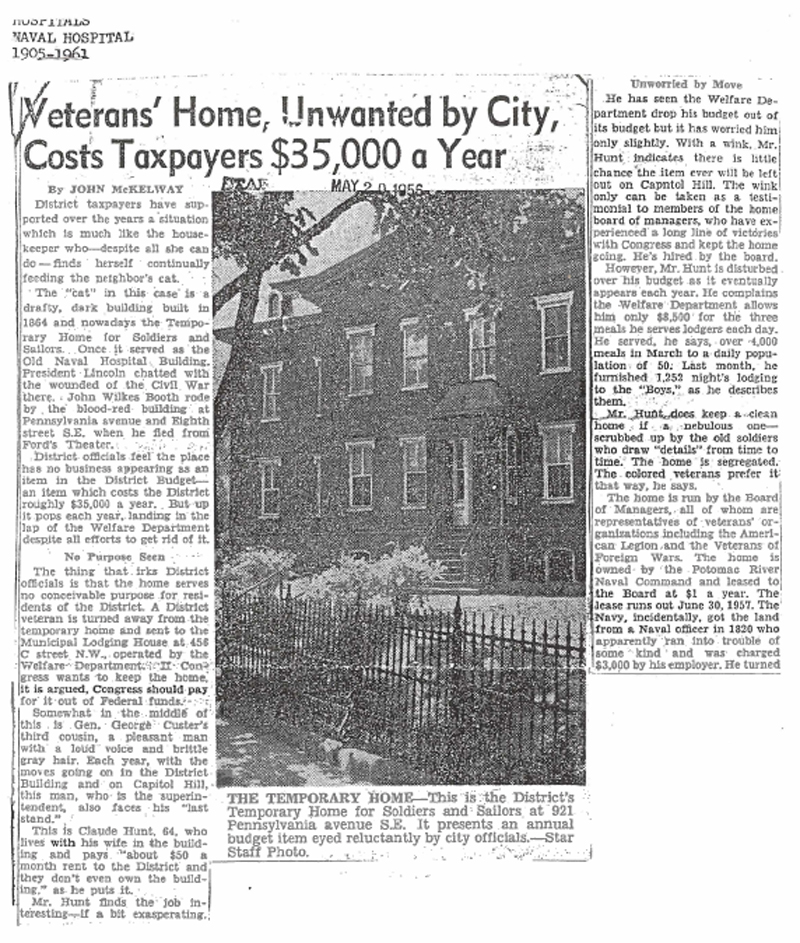

District taxpayers have supported over the years a situation which is much like the house-keeper who-despite all she can do -finds ' herself ' continually feeding the neighbor's cat.
The “Cat" in this case is a drafty, dark building built in 1864 and nowadays the Temporary Home for Soldiers and Sailors. Once it served as the Old Naval Hospital Building. President .Lincoln chatted with the wounded of the Civil War there. John Wilkes Booth rode by the blood-red building at Pennsylvania avenue and Eighth street S.E. when, he fled from Ford's Theater.
District officials feel the place has no business appearing as an item in the District Budget - an item which costs the District roughly $35,000 a year. But up it pops each year, landing in the lap of the Welfare Department despite all efforts to get rid of it.
The thing that irks District officials is that the home serves no conceivable purpose for residents of the District. A District veteran is turned away from the temporary home and sent to the Municipal Lodging House at 456 C street N.W., operated by: the We1fare Department. If Congress wants to keep the home, it is argued, Congress should pay for it out of Federal funds.
Somewhat in the middle of' this is Gen. George Custer's third cousin, a pleasant man with a loud voice and brittle gray hair. Each year, with the moves going on in the District Building and on Capitol Hill, this man, who is the superintendent, also faces his "last stand.”
This is Claude Hunt, 64, who lives with his wife in the building and pays "about $50 a month rent to the District and they don't even own the building" as he puts it.
Mr. Hunt finds the job interesting – if a bit exasperating.
(Caption under the photograph) The Temporary Home – This is the District’s Temporary Home for Soldiers and Sailors, at 921 Pennsylvania avenue S.E. it presents an annual budget item eyed reluctantly by city officials. – Star Staff Photo.
He has seen the Welfare Department drop his budget out of its budget but is has worried him only slightly. With a wink, Mr. Hunt indicates there is little chance the item wi8ll ever be left out on Capitol Hill. The wink only can be taken as a testimonial to members of the home board of managers, who have experienced a long line of victories with Congress and kept the home going. He's hired by the board.
However, Mr. Hunt is disturbed over his budget as it eventually appears each year. He complains the Welfare Department allows him only $8,500 for the three meals he serves lodgers each day. He served, he says, over 4,000 meals in March to a daily population of 50. Last month, he furnished 1,252 night’s lodging to the “Boys, as he described them.
Mr. Hunt does keep a clean home, if a nebulous one – scrubbed up by the old soldiers who draw “details” from time to time. The home is segregated. The colored veterans prefer it that way, he says.
The home is run by the Board of Managers, all of whom are representatives of veterans' organizations including the American Legion and the Veterans of Foreign Wars. The home is owned by the Potomac River Naval Command and leased to the Board at $1 a year. The lease runs out June 30, 1957. The Navy, incidentally, got the land from a Naval officer in 1820 who apparently ran into trouble of some kind and was charged $3,000 by his employer. He turned (continued on page 2)
This site is sponsored by the Friends of the Old Naval Hospital
Last updated July 27, 2009